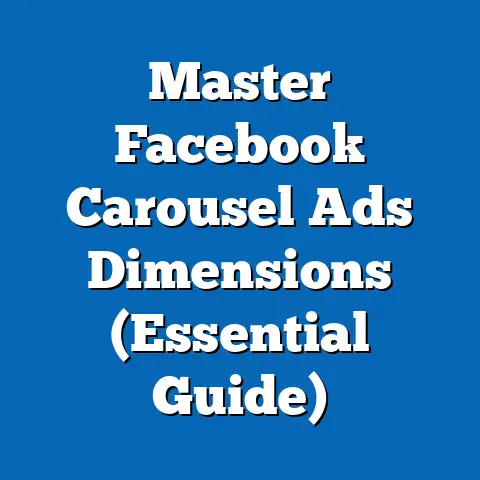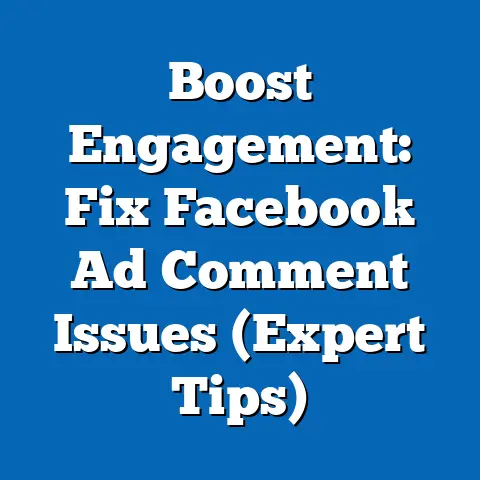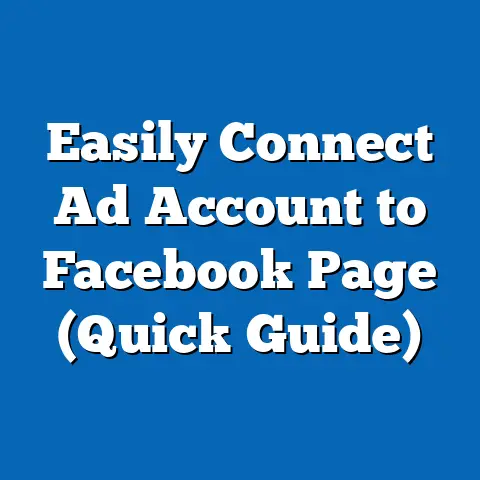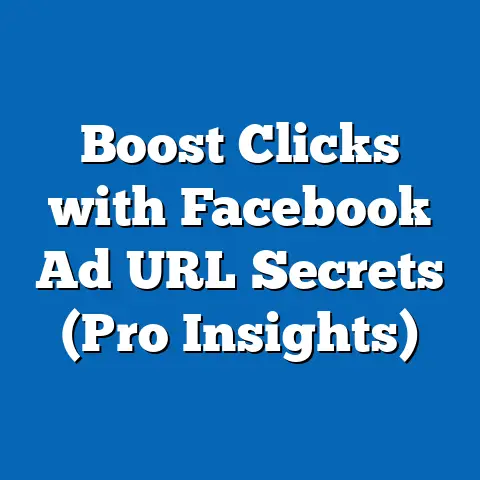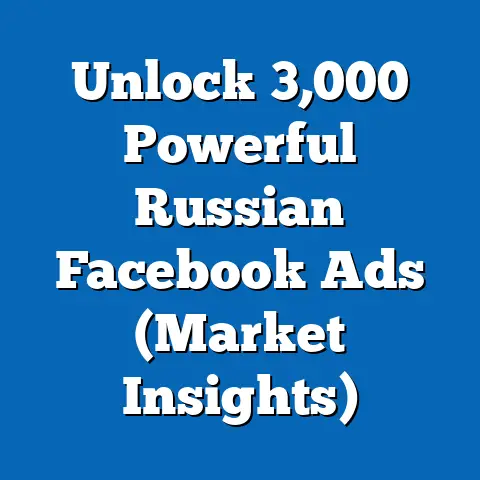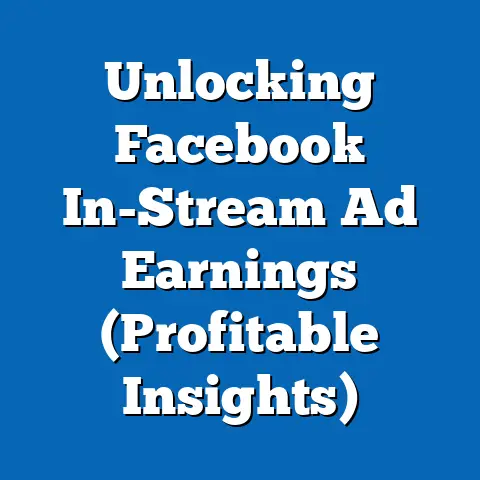Boost Facebook Ad Team’s Success (Winning Strategies)
It’s funny, I remember when Facebook advertising was the new kid on the block. Back then, it felt like the Wild West – anyone could throw up an ad and see some results. But those days are long gone. Today, the Facebook ads ecosystem is a sophisticated, competitive arena where only the most strategic and well-equipped teams thrive. I’ve seen firsthand how a well-oiled Facebook ad team can transform a business, and conversely, how a poorly managed one can burn through a budget faster than you can say “cost per acquisition.” That’s why I’m so passionate about sharing what I’ve learned over the years about building and leading high-performing Facebook ad teams.
Facebook ads, when done right, are a powerful tool in any digital marketing arsenal. They offer unparalleled reach, granular targeting, and a wide array of creative formats. However, the platform is constantly evolving, and success requires more than just basic knowledge – it demands a strategic approach, data-driven decision-making, and a team that’s always learning and adapting.
In this article, I’m going to dive deep into the winning strategies that can boost your Facebook ad team’s success. From understanding the intricacies of the Facebook ads ecosystem to building a team with the right skills and mindset, from crafting compelling ad content to mastering advanced targeting strategies, and from budgeting wisely to staying ahead of the curve, I’ll cover everything you need to know to take your team’s performance to the next level. Let’s get started!
Understanding the Facebook Ads Ecosystem
Before we jump into the strategies, it’s crucial to understand the playing field. Facebook advertising is more than just creating an ad and hitting “publish.” It’s a complex ecosystem with its own rules, nuances, and ever-changing dynamics.
Overview of Facebook Ads
Facebook ads operate on an auction-based system. Advertisers bid for ad space, and Facebook’s algorithm determines which ads to show based on a variety of factors, including bid amount, ad quality, and relevance to the user. This means that simply having the highest bid doesn’t guarantee success. Your ad also needs to be engaging, relevant, and likely to generate the desired outcome (e.g., clicks, conversions).
Facebook offers a wide range of ad formats, from simple image ads to engaging video ads, carousel ads, and collection ads. Each format has its own strengths and weaknesses, and the best choice depends on your specific goals and target audience.
Targeting options are another key component of the Facebook ads ecosystem. You can target users based on demographics, interests, behaviors, and connections. This allows you to reach a highly specific audience and tailor your message accordingly.
The Role of Algorithms
Facebook’s algorithms are the invisible hand that guides the entire advertising process. These algorithms are constantly learning and evolving, analyzing user behavior and ad performance to determine which ads to show to which users.
Understanding how these algorithms work is crucial for ad teams. For example, the algorithm favors ads that are engaging and relevant to the user. This means that you need to create high-quality content that resonates with your target audience. The algorithm also rewards ads that have a high click-through rate (CTR) and conversion rate. This means that you need to optimize your ads for performance and continuously test different variations to see what works best.
One of the biggest changes I’ve seen in recent years is the increasing emphasis on machine learning. Facebook is using machine learning to automate many aspects of the advertising process, from ad placement to bidding. This means that ad teams need to be comfortable working with machine learning and understanding how to leverage it to their advantage.
The Competitive Landscape
The Facebook advertising landscape is incredibly competitive. Millions of businesses are vying for the attention of Facebook’s users, and this competition drives up ad costs.
To succeed in this competitive environment, you need to be innovative and strategic. You need to find ways to stand out from the crowd and capture the attention of your target audience. You also need to be constantly testing and optimizing your ads to improve performance and reduce costs.
One of the most effective ways to stay ahead of the competition is to focus on creating high-quality content that provides value to your target audience. This could be informative articles, engaging videos, or entertaining memes. By providing value, you can build trust and credibility, which can lead to increased engagement and conversions.
Takeaway: Understanding the Facebook ads ecosystem, including the auction system, algorithms, and competitive landscape, is essential for building a successful ad team.
Building a High-Performing Facebook Ad Team
Now that we have a solid understanding of the Facebook ads ecosystem, let’s talk about building a team that can thrive in this environment. A high-performing Facebook ad team is more than just a group of individuals – it’s a cohesive unit with the right skills, mindset, and processes.
Team Structure
The ideal structure of a Facebook ad team depends on the size and complexity of your business. However, there are a few key roles that are essential for success:
- Ad Strategist: The ad strategist is responsible for developing the overall advertising strategy and ensuring that it aligns with the business goals. They need to have a deep understanding of the Facebook ads ecosystem, as well as strong analytical and problem-solving skills.
- Ad Copywriter: The ad copywriter is responsible for writing compelling and persuasive ad copy that resonates with the target audience. They need to have excellent writing skills, as well as a strong understanding of marketing principles.
- Graphic Designer: The graphic designer is responsible for creating visually appealing and engaging ad creatives. They need to have strong design skills, as well as a good understanding of branding and visual communication.
- Data Analyst: The data analyst is responsible for tracking and analyzing ad performance data. They need to have strong analytical skills, as well as a good understanding of statistics and data visualization.
- Social Media Manager: The social media manager is responsible for managing the company’s social media presence and ensuring that it aligns with the advertising strategy. They need to have excellent communication skills, as well as a good understanding of social media marketing principles.
In smaller organizations, one person might wear multiple hats. For example, the ad strategist might also be the data analyst. However, as your business grows, it’s important to have dedicated individuals for each role.
Skill Development
Having the right team structure is only half the battle. You also need to ensure that your team members have the right skills. Here are some of the key skills that are essential for a high-performing Facebook ad team:
- Data Analysis: The ability to analyze data and draw meaningful insights is crucial for optimizing ad performance.
- Creative Thinking: The ability to come up with innovative and engaging ad concepts is essential for standing out from the crowd.
- Platform-Specific Knowledge: A deep understanding of the Facebook ads platform, including its features, tools, and best practices, is essential for success.
- Marketing Principles: A solid understanding of marketing principles, such as segmentation, targeting, and positioning, is essential for developing effective advertising strategies.
- Communication Skills: Excellent communication skills are essential for collaborating with other team members and communicating effectively with clients.
One of the best ways to develop these skills is through ongoing training and education. Encourage your team members to attend industry conferences, take online courses, and read relevant articles and books. Also, encourage them to experiment and try new things. The best way to learn is by doing.
Collaboration and Communication
A high-performing Facebook ad team is a team that works together effectively. This means that team members need to be able to collaborate and communicate effectively.
One of the best ways to foster collaboration is to create a culture of open communication. Encourage team members to share their ideas, ask questions, and provide feedback. Also, make sure that everyone is on the same page in terms of goals, strategies, and timelines.
Another important aspect of collaboration is using the right tools. There are many tools available that can help teams collaborate more effectively, such as project management software, communication platforms, and data visualization tools.
Takeaway: Building a high-performing Facebook ad team requires a well-defined structure, skilled individuals, and a culture of collaboration and communication.
Data-Driven Decision Making
In the world of Facebook advertising, data is king. Without data, you’re just guessing. Data-driven decision-making is the process of using data to inform your advertising strategies and optimize your campaigns for performance.
Importance of Analytics
Data analysis is critical to the success of Facebook ad campaigns for several reasons:
- It allows you to understand your target audience: By analyzing data, you can learn more about your target audience, including their demographics, interests, behaviors, and preferences. This information can help you tailor your ad content and targeting strategies to resonate with them more effectively.
- It allows you to track ad performance: By tracking ad performance data, you can see how your ads are performing and identify areas for improvement. This information can help you optimize your ads for performance and reduce costs.
- It allows you to measure ROI: By measuring the return on investment (ROI) of your ad campaigns, you can see how much money you’re making from your advertising efforts. This information can help you make informed decisions about your advertising budget and strategy.
I remember one client who was convinced that a particular ad was performing well, simply because they liked the creative. However, when we dug into the data, we discovered that the ad had a low click-through rate and a high cost per acquisition. By analyzing the data, we were able to identify the problem and make changes that significantly improved performance.
Key Metrics to Monitor
There are many metrics that you can track in Facebook ads, but some are more important than others. Here are some of the key metrics that ad teams should focus on:
- Click-Through Rate (CTR): The CTR is the percentage of people who see your ad and click on it. A high CTR indicates that your ad is engaging and relevant to your target audience.
- Conversion Rate: The conversion rate is the percentage of people who click on your ad and take the desired action (e.g., make a purchase, sign up for a newsletter). A high conversion rate indicates that your ad is effective at driving conversions.
- Cost Per Acquisition (CPA): The CPA is the cost of acquiring a new customer through your ad campaign. A low CPA indicates that your ad campaign is efficient at generating new customers.
- Return on Ad Spend (ROAS): The ROAS is the amount of revenue you generate for every dollar you spend on advertising. A high ROAS indicates that your ad campaign is profitable.
- Relevance Score: The relevance score is a metric that Facebook uses to measure the relevance of your ad to your target audience. A high relevance score indicates that your ad is highly relevant to your target audience.
It’s important to track these metrics on a regular basis and analyze them to identify trends and patterns. This information can help you make informed decisions about your advertising strategies and optimize your campaigns for performance.
A/B Testing
A/B testing, also known as split testing, is the process of testing two or more versions of an ad to see which one performs better. A/B testing is a powerful tool for refining ad content and targeting strategies to maximize effectiveness.
Here are some of the things you can A/B test in Facebook ads:
- Ad Copy: Test different headlines, descriptions, and calls to action to see which ones resonate best with your target audience.
- Ad Creatives: Test different images, videos, and other visual elements to see which ones capture the most attention.
- Targeting: Test different targeting options to see which ones reach the most qualified audience.
- Bidding Strategies: Test different bidding strategies to see which ones generate the best results at the lowest cost.
When A/B testing, it’s important to test only one variable at a time. This will allow you to isolate the impact of each variable and determine which one is driving the results. Also, make sure to run your A/B tests for a sufficient amount of time to gather enough data to make statistically significant conclusions.
Takeaway: Data-driven decision-making is essential for optimizing Facebook ad campaigns. Track key metrics, analyze the data, and use A/B testing to refine your ad content and targeting strategies.
Crafting Compelling Ad Content
Even the most sophisticated targeting and bidding strategies will fall flat if your ad content isn’t compelling. Crafting compelling ad content is about understanding your target audience, creating engaging visuals, and writing persuasive copy.
Understanding the Target Audience
The first step in crafting compelling ad content is to understand your target audience. Who are they? What are their interests, needs, and pain points? What motivates them to take action?
There are many ways to gather information about your target audience. You can use Facebook’s Audience Insights tool to learn more about their demographics, interests, and behaviors. You can also conduct surveys, interviews, and focus groups to gather qualitative data.
Once you have a good understanding of your target audience, you can tailor your ad content to resonate with them more effectively. This means using language, imagery, and messaging that speaks to their specific needs and interests.
Creating Engaging Visuals
Visuals are a critical component of Facebook ads. They’re the first thing people see, and they play a big role in capturing attention and driving engagement.
Here are some tips for creating engaging visuals for your Facebook ads:
- Use high-quality images and videos: Make sure your visuals are clear, crisp, and visually appealing.
- Use relevant visuals: Choose visuals that are relevant to your ad copy and your target audience.
- Use eye-catching visuals: Use visuals that stand out from the crowd and capture attention.
- Use visuals that tell a story: Use visuals that tell a story and evoke emotion.
- Test different visuals: A/B test different visuals to see which ones perform best.
I’ve found that video ads tend to be particularly effective on Facebook. Video is a highly engaging format that can capture attention and convey complex information in a short amount of time. However, it’s important to create videos that are visually appealing, well-produced, and relevant to your target audience.
Writing Persuasive Copy
The ad copy is the text that accompanies your visuals. It’s your opportunity to tell your target audience what you have to offer and persuade them to take action.
Here are some tips for writing persuasive copy for your Facebook ads:
- Write clear and concise copy: Get straight to the point and avoid using jargon or technical terms.
- Focus on the benefits: Highlight the benefits of your product or service, rather than just the features.
- Use strong calls to action: Tell your target audience what you want them to do (e.g., “Shop Now,” “Learn More,” “Sign Up”).
- Use persuasive language: Use language that is persuasive and compelling.
- Test different copy variations: A/B test different copy variations to see which ones perform best.
One of the most effective copywriting techniques I’ve found is to use the AIDA formula:
- Attention: Grab the reader’s attention with a compelling headline or opening line.
- Interest: Generate interest by highlighting the benefits of your product or service.
- Desire: Create desire by showing how your product or service can solve the reader’s problem or fulfill their need.
- Action: Ask the reader to take action with a clear and compelling call to action.
Takeaway: Crafting compelling ad content is about understanding your target audience, creating engaging visuals, and writing persuasive copy.
Advanced Targeting Strategies
One of the biggest advantages of Facebook advertising is its ability to target highly specific audiences. Mastering advanced targeting strategies can significantly improve the performance of your ad campaigns.
Utilizing Audience Insights
Facebook’s Audience Insights tool is a powerful resource for understanding your target audience. It provides detailed information about their demographics, interests, behaviors, and preferences.
You can use Audience Insights to:
- Identify potential target audiences: By exploring different demographics, interests, and behaviors, you can discover new target audiences that you may not have considered before.
- Learn more about your existing target audiences: By analyzing the data for your existing target audiences, you can gain a deeper understanding of their needs and preferences.
- Tailor your ad content: By understanding the interests and behaviors of your target audience, you can tailor your ad content to resonate with them more effectively.
I often use Audience Insights to research new markets or to refine my understanding of existing customer segments. It’s a great way to validate assumptions and uncover hidden insights.
Custom and Lookalike Audiences
Custom and lookalike audiences are two of the most powerful targeting options in Facebook ads.
- Custom Audiences: Custom audiences allow you to target users who have already interacted with your business in some way. You can create custom audiences based on website traffic, customer lists, app activity, and more.
- Lookalike Audiences: Lookalike audiences allow you to target users who are similar to your existing customers. You can create lookalike audiences based on your custom audiences.
Custom and lookalike audiences are particularly effective for retargeting and for expanding your reach to new customers who are likely to be interested in your products or services.
Retargeting Campaigns
Retargeting is the process of targeting users who have previously engaged with your ads or visited your website. Retargeting campaigns are highly effective because they target users who are already familiar with your brand and have shown some level of interest in your products or services.
Here are some tips for creating effective retargeting campaigns:
- Segment your retargeting audiences: Segment your retargeting audiences based on their behavior (e.g., users who visited a specific product page, users who added items to their cart but didn’t complete the purchase).
- Tailor your ad content: Tailor your ad content to the specific behavior of each retargeting audience.
- Offer incentives: Offer incentives, such as discounts or free shipping, to encourage users to take action.
I’ve seen some of my most successful campaigns using retargeting. Reminding potential customers about products they’ve viewed or offering them a special deal can be a powerful way to drive conversions.
Takeaway: Mastering advanced targeting strategies, such as utilizing Audience Insights, creating custom and lookalike audiences, and implementing retargeting campaigns, can significantly improve the performance of your Facebook ad campaigns.
Budgeting and Bidding Strategies
Effective budgeting and bidding strategies are essential for maximizing the return on investment of your Facebook ad campaigns.
Setting a Budget
Setting a budget for your Facebook ad campaigns is a critical decision that should be based on your business goals and your overall marketing budget.
Here are some factors to consider when setting a budget:
- Your Business Goals: What are you trying to achieve with your Facebook ad campaigns? Are you trying to generate leads, drive sales, or increase brand awareness?
- Your Marketing Budget: How much money do you have available to spend on advertising?
- Your Target Audience: How large is your target audience? The larger your target audience, the more money you will need to spend to reach them.
- Your Competition: How much are your competitors spending on advertising?
- Your Expected ROI: What is your expected return on investment (ROI) for your Facebook ad campaigns?
Once you have considered these factors, you can set a budget that is appropriate for your business goals and your overall marketing budget.
Bidding Options
Facebook offers several different bidding options, each with its own advantages and disadvantages.
Here are some of the most common bidding options:
- Cost Per Click (CPC): With CPC bidding, you pay each time someone clicks on your ad.
- Cost Per Mille (CPM): With CPM bidding, you pay for every 1,000 impressions of your ad.
- Cost Per Action (CPA): With CPA bidding, you pay only when someone takes the desired action (e.g., makes a purchase, signs up for a newsletter).
- Value Optimization: With value optimization, Facebook automatically optimizes your bids to maximize the value of each conversion.
The best bidding option for you depends on your specific goals and your overall advertising strategy.
Maximizing ROI
Maximizing ROI is the ultimate goal of any advertising campaign. Here are some strategies for maximizing the ROI of your Facebook ad campaigns:
- Target the right audience: Make sure you are targeting the right audience with your ads.
- Create compelling ad content: Create ad content that is engaging and relevant to your target audience.
- Optimize your bidding strategies: Optimize your bidding strategies to get the best results at the lowest cost.
- Track your results: Track your results and make adjustments as needed.
- A/B test everything: A/B test everything to see what works best.
I’ve found that one of the most effective ways to maximize ROI is to focus on creating high-quality content that provides value to your target audience. When you provide value, you build trust and credibility, which can lead to increased engagement and conversions.
Takeaway: Effective budgeting and bidding strategies are essential for maximizing the ROI of your Facebook ad campaigns. Set a budget that is appropriate for your business goals, choose the right bidding options, and implement strategies to maximize ROI.
Staying Ahead of Trends
The Facebook advertising landscape is constantly evolving. New trends emerge, platform updates are released, and user behavior changes. To stay ahead of the curve, it’s important to be agile, adaptable, and committed to continuous learning.
Emerging Trends in Facebook Advertising
Here are some of the emerging trends in Facebook advertising:
- The Rise of Video Content: Video is becoming increasingly popular on Facebook, and video ads are performing well.
- Interactive Ads: Interactive ads, such as polls and quizzes, are a great way to engage users and drive conversions.
- Augmented Reality (AR) Ads: AR ads allow users to try on products virtually, which can be a great way to drive sales.
- Personalized Advertising: Personalized advertising is becoming increasingly important, as users expect to see ads that are relevant to their interests.
- Privacy-Focused Advertising: With increasing concerns about privacy, advertisers need to be more transparent about how they are using data and provide users with more control over their advertising experience.
Adapting to Changes
Facebook is constantly making changes to its platform, and it’s important to be able to adapt to these changes quickly. This means staying up-to-date on the latest news and updates, and being willing to experiment with new features and strategies.
One of the biggest challenges I’ve faced over the years is adapting to changes in Facebook’s algorithm. The algorithm is constantly evolving, and what worked yesterday may not work today. That’s why it’s so important to be constantly testing and optimizing your ads to stay ahead of the curve.
Continuous Learning
Continuous learning is essential for any Facebook ad team. This means staying up-to-date on the latest trends, best practices, and platform updates. It also means being willing to experiment and try new things.
There are many ways to stay up-to-date on the latest trends in Facebook advertising:
- Read industry blogs and articles: There are many great blogs and articles that cover Facebook advertising.
- Attend industry conferences: Industry conferences are a great way to learn from experts and network with other professionals.
- Take online courses: There are many online courses that cover Facebook advertising.
- Experiment with new features: Be willing to experiment with new features and strategies.
Takeaway: Staying ahead of trends requires agility, adaptability, and a commitment to continuous learning.
Case Studies and Success Stories
Real-world examples can provide valuable insights and inspiration for your own Facebook ad campaigns. Let’s take a look at a few case studies and success stories.
Real-World Examples
- Dollar Shave Club: Dollar Shave Club used a humorous video ad to disrupt the razor industry and acquire millions of customers. The ad was funny, engaging, and clearly communicated the benefits of their product.
- Airbnb: Airbnb used targeted Facebook ads to reach travelers who were interested in specific destinations. They showed ads featuring unique properties in those destinations, which resonated with their target audience.
- Warby Parker: Warby Parker used a combination of targeted ads and engaging content to build brand awareness and drive sales. They created a series of videos that showcased their glasses and told the stories of their customers.
Lessons Learned
Here are some key takeaways from these case studies:
- Be authentic: Be authentic and genuine in your advertising.
- Focus on the benefits: Focus on the benefits of your product or service, rather than just the features.
- Tell a story: Tell a story that resonates with your target audience.
- Be creative: Be creative and innovative in your advertising.
- Test everything: Test everything to see what works best.
Takeaway: Case studies and success stories can provide valuable insights and inspiration for your own Facebook ad campaigns.
Conclusion
Facebook advertising is a powerful tool that can help businesses reach their target audience and achieve their marketing goals. However, success requires more than just basic knowledge – it demands a strategic approach, data-driven decision-making, and a team that’s always learning and adapting.
In this article, I’ve covered the winning strategies that can boost your Facebook ad team’s success. From understanding the intricacies of the Facebook ads ecosystem to building a team with the right skills and mindset, from crafting compelling ad content to mastering advanced targeting strategies, and from budgeting wisely to staying ahead of the curve, I’ve shared everything you need to know to take your team’s performance to the next level.
By implementing these strategies, you can significantly enhance the success of your Facebook ad team and drive impactful results for your brand. Remember to stay agile, adaptable, and committed to continuous learning. The Facebook advertising landscape is constantly evolving, and the teams that thrive are the ones that are willing to embrace change and experiment with new strategies.
Now, go out there and build a winning Facebook ad team! The possibilities are endless.

